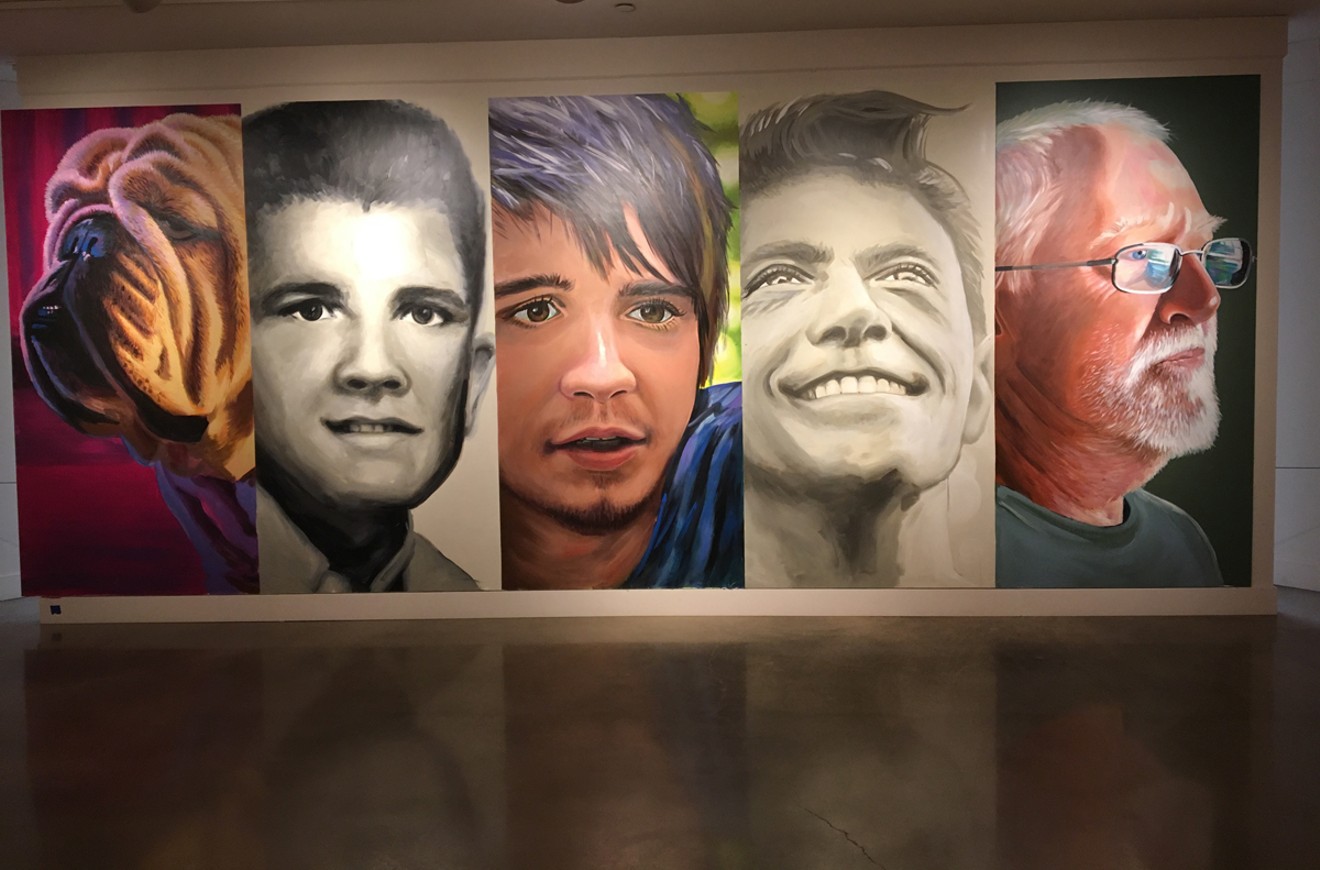But one of the new things that particularly bugs me, probably because I’ve been an art critic for so long, is the conceit — all the rage around town now — that anyone with a paintbrush and a blank wall can create an outdoor mural. My basic feeling is that if someone wants to paint a mural, he or she must first ask this question: Am I Diego Rivera? If the answer is yes, then get to work on that wall. If it’s no, don’t touch it.
It’s clear from the murals popping up around Denver that too few painters are asking themselves this question. But there are some worthwhile pieces, too, and those surely sparked Collin Parson’s idea of compiling a list of mural artists, then inviting them to create work for In Sight On Site, the current show at the Arvada Center for the Arts and Humanities. Although outdoor murals are usually painted directly on walls, these artists were given panels that were then screwed to the walls, allowing the murals to be removed when the show is over. The artists were also provided paint and other supplies. Because of concerns over air quality inside the Arvada Center while they were completing their works, neither spray paint nor oil paint were allowed; instead, everything had to be done with less toxic materials, mostly latex acrylic.
The resulting show is beautifully laid out through all three galleries, with each mural on a specific wall so that the design isn’t too tight — yet the vista views in which you can see several murals at once are unrelentingly impressive. With 21 murals by 22 artists (two working as a pair), it’s almost overwhelming.
Parson has not designed the exhibit to make any particular stylistic, thematic or narrative points; instead, In Sight On Site is kind of a snapshot of the scene. Even so, the murals included fall into three clearly articulated categories. First are the abstractions, many of which feature patterns, either geometric or organic. Second are the figurations, ranging from photorealist style to updated versions of the Chicano mural movement of the ’60s and ’70s (which traces its origins to — you guessed it — Diego Rivera). Finally, there are the storybook, 420-friendly fantasy-style murals. Parson has stacked the deck, so the ratio doesn’t reflect the stylistic proportions of actual outdoor murals in this town — and that’s a good thing. Abstractions are most abundant here, followed by figurative murals and then fantasy pieces. That’s exactly the opposite of what you’d find on the streets, where the 420 stuff is the most common type and abstractions play only a minor role.
With its interactive component, “Untitled” by Thomas “Detour” Evans is one of the most ambitious and successful of the abstractions. On a hard-edged constructivist composition of zigzags done in bright colors, Evans has mounted brackets that act like bridges for sets of strings. The strings are meant to be touched (though not plucked); when they are, a digital audio system conveys the sound of a musical note, making it conceivably possible for someone to play a tune on the mural. Though Evans employs geometry, he doesn’t create a pattern. But several other artists do, notably Sandra Fettingis, whose pattern paintings are among the most accomplished murals around town. Her signature style is readily recognizable, and her compositions are complex and linear.
Other artists who successfully play with organizing geometric elements include Ramón Bonilla and Andrew Hoffman, both doing murals that recall vanguard art of a century ago. For his piece, Anthony Garcia Sr. requested panels impressed with a faux brick pattern, which he then covered repeatedly with graffiti before putting on a final coat of stripes for a geometric result. A video of the process is shown in a nearby niche. Other impressive abstracts include Sabin Aell’s combination of geometric and organic forms colliding with each other in “Elle,” as well as Thomas Scharfenberg’s dazzling “0-1/1-5,” an over-the-top riot of simple forms in sunny colors. Heather Patterson’s “Climate System” is completely lyrical, even if the title suggests a dark subtext; it’s an abstracted aerial view of a landscape receding behind a skeletal structure at the picture plane. I also loved the pop-meets-Basquiat look of Max Kauffman’s “behold a pale walker.”
The figurative category includes “5 degrees of inspiration,” by Patrick Kane McGregor, five hyperrealist portraits lined up in a row that include renditions of four people who are close to him, as well as his pet dog. Just as realistic, though the subject is surrealistic, is Mark Penner-Howell’s painting of two men yelling at each other, linked by a rope that ties hands in each of their minds and then runs out of their mouths.
Three murals riffing on the Chicano mural tradition also present representational imagery. Like Fettingis, Jaime Molina is renowned for his outdoor murals; his conventionalized Latino characters are recognizable and appear all over town. Tony Ortega, who had a class of young students color in the shapes of a drawing he did for his mural, conventionalizes the figure, too. Also in the Chicano camp are the hieratic portraits by Los Supersonicos, an artist pair comprising Carlos Frésquez and Francisco Zamora.

"Chicano Strength and Power" by Los Supersonicos (Carlos Fresquez and Francisco Zamora), paint on panel.
Michael Paglia
Parson did a great job of showcasing the range of expressions that artists employ in contemporary mural painting. Now if we could just get him to curate the murals actually out on Denver’s streets.
In Sight On Site, through August 26, Arvada Center for the Arts and Humanities, 6901 Wadsworth Boulevard, Arvada. For more information, call 720-898-7200 or go to arvadacenter.org.














